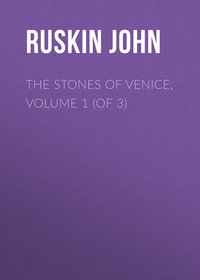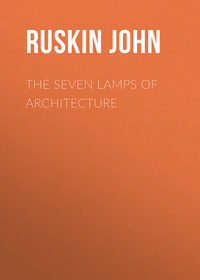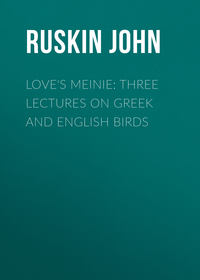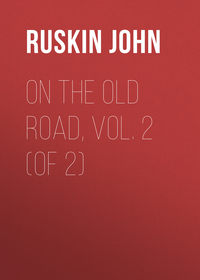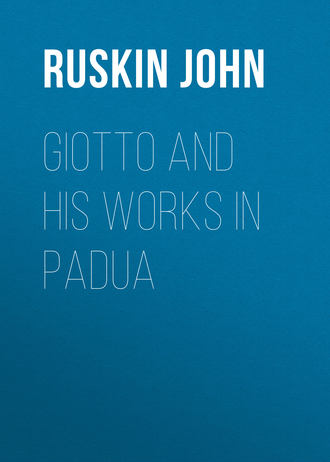 полная версия
полная версияGiotto and his works in Padua
But what, it may be said by the reader, is the use of the works of Giotto to us? They may indeed have been wonderful for their time, and of infinite use in that time; but since, after Giotto, came Leonardo and Correggio, what is the use of going back to the ruder art, and republishing it in the year 1854? Why should we fret ourselves to dig down to the root of the tree, when we may at once enjoy its fruit and foliage? I answer, first, that in all matters relating to human intellect, it is a great thing to have hold of the root: that at least we ought to see it, and taste it, and handle it; for it often happens that the root is wholesome when the leaves, however fair, are useless or poisonous. In nine cases out of ten, the first expression of an idea is the most valuable: the idea may afterward be polished and softened, and made more attractive to the general eye; but the first expression of it has a freshness and brightness, like the flash of a native crystal compared to the lustre of glass that has been melted and cut. And in the second place, we ought to measure the value of art less by its executive than by its moral power. Giotto was not indeed one of the most accomplished painters, but he was one of the greatest men, who ever lived. He was the first master of his time, in architecture as well as in painting; he was the friend of Dante, and the undisputed interpreter of religious truth, by means of painting, over the whole of Italy. The works of such a man may not be the best to set before children in order to teach them drawing; but they assuredly should be studied with the greatest care by all who are interested in the history of the human mind.
One point more remains to be noticed respecting him. As far as I am aware, he never painted profane subjects. All his important existing works are exclusively devoted to the illustration of Christianity. This was not a result of his own peculiar feeling or determination; it was a necessity of the period. Giotto appears to have considered himself simply as a workman, at the command of any employer, for any kind of work, however humble. "In the sixty-third novel of Franco Sacchetti we read that a stranger, suddenly entering Giotto's study, threw down a shield, and departed, saying, 'Paint me my arms on that shield.' Giotto looking after him, exclaimed, 'Who is he? What is he? He says, "Paint me my arms," as if he was one of the Bardi. What arms does he bear?'"7 But at the time of Giotto's eminence, art was never employed on a great scale except in the service of religion; nor has it ever been otherwise employed, except in declining periods. I do not mean to draw any severe conclusion from this fact; but it is a fact nevertheless, which ought to be very distinctly stated, and very carefully considered. All progressive art hitherto has been religious art; and commencements of the periods of decline are accurately marked, in illumination, by its employment on romances instead of psalters; and in painting, by its employment on mythology or profane history instead of sacred history. Yet perhaps I should rather have said, on heathen mythology instead of Christian mythology; for this latter term—first used, I believe, by Lord Lindsay—is more applicable to the subjects of the early painters than that of "sacred history." Of all the virtues commonly found in the higher orders of human mind, that of a stern and just respect for truth seems to be the rarest; so that while self-denial, and courage, and charity, and religious zeal, are displayed in their utmost degrees by myriads of saints and heroes, it is only once in a century that a man appears whose word may be implicitly trusted, and who, in the relation of a plain fact, will not allow his prejudices or his pleasure to tempt him to some colouring or distortion of it. Hence the portions of sacred history which have been the constant subjects of fond popular contemplation have, in the lapse of ages, been encumbered with fictitious detail; and their various historians seem to have considered the exercise of their imagination innocent, and even meritorious, if they could increase either the vividness of conception or the sincerity of belief in their readers. A due consideration of that well-known weakness of the popular mind, which renders a statement credible in proportion to the multitude of local and circumstantial details which accompany it, may lead us to look with some indulgence on the errors, however fatal in their issue to the cause they were intended to advance, of those weak teachers, who thought the acceptance of their general statements of Christian doctrine cheaply won by the help of some simple (and generally absurd) inventions of detail respecting the life of the Virgin or the Apostles.
Indeed, I can hardly imagine the Bible to be ever read with true interest, unless, in our reading, we feel some longing for further knowledge of the minute incidents of the life of Christ,—for some records of those things, which "if they had been written every one," the world could not have contained the books that should be written: and they who have once felt this thirst for further truth, may surely both conceive and pardon the earnest questioning of simple disciples (who knew not, as we do, how much had been indeed revealed), and measure with some justice the strength of the temptation which betrayed these teachers into adding to the word of Revelation. Together with this specious and subtle influence, we must allow for the instinct of imagination exerting itself in the acknowledged embellishment of beloved truths. If we reflect how much, even in this age of accurate knowledge, the visions of Milton have become confused in the minds of many persons with scriptural facts, we shall rather be surprised, that in an age of legends so little should be added to the Bible, than that occasionally we should be informed of important circumstances in sacred history with the collateral warning, "This Moses spake not of."8
More especially in the domain of painting, it is surprising to see how strictly the early workmen confined themselves to representations of the same series of scenes; how little of pictorial embellishment they usually added; and how, even in the positions and gestures of figures, they strove to give the idea rather of their having seen the fact, than imagined a picturesque treatment of it. Often, in examining early art, we mistake conscientiousness for servility, and attribute to the absence of invention what was indeed the result of the earnestness of faith.
Nor, in a merely artistical point of view, is it less important to note, that the greatest advance in power was made when painters had few subjects to treat. The day has perhaps come when genius should be shown in the discovery of perpetually various interest amidst the incidents of actual life; and the absence of inventive capacity is very assuredly proved by the narrow selection of subjects which commonly appear on the walls of our exhibitions. But yet it is to be always remembered, that more originality may be shown in giving interest to a well-known subject than in discovering a new one; that the greatest poets whom the world has seen have been contented to retouch and exalt the creations of their predecessors; and that the painters of the middle ages reached their utmost power by unweariedly treading a narrow circle of sacred subjects.
Nothing is indeed more notable in the history of art than the exact balance of its point of excellence, in all things, midway between servitude and license. Thus, in choice and treatment of subject it became paralysed among the Byzantines, by being mercilessly confined to a given series of scenes, and to a given mode of representing them. Giotto gave it partial liberty and incipient life; by the artists who succeeded him the range of its scenery was continually extended, and the severity of its style slowly softened to perfection. But the range was still, in some degree, limited by the necessity of its continual subordination to religious purposes; and the style, though softened, was still chaste, and though tender, self-restrained. At last came the period of license: the artist chose his subjects from the lowest scenes of human life, and let loose his passions in their portraiture. And the kingdom of art passed away.
As if to direct us to the observation of this great law, there is a curious visible type of it in the progress of ornamentation in manuscripts, corresponding with the various changes in the higher branch of art. In the course of the 12th and early 13th centuries, the ornamentation, though often full of high feeling and fantasy, is sternly enclosed within limiting border-lines;—at first, severe squares, oblongs, or triangles. As the grace of the ornamentation advances, these border-lines are softened and broken into various curves, and the inner design begins here and there to overpass them. Gradually this emergence becomes more constant, and the lines which thus escape throw themselves into curvatures expressive of the most exquisite concurrence of freedom with self-restraint. At length the restraint vanishes, the freedom changes consequently into license, and the page is covered with exuberant, irregular, and foolish extravagances of leafage and line.
It only remains to be noticed, that the circumstances of the time at which Giotto appeared were peculiarly favourable to the development of genius; owing partly to the simplicity of the methods of practice, and partly to the naïveté with which art was commonly regarded. Giotto, like all the great painters of the period, was merely a travelling decorator of walls, at so much a day; having at Florence a bottega, or workshop, for the production and sale of small tempera pictures. There were no such things as "studios" in those days. An artist's "studies" were over by the time he was eighteen; after that he was a lavoratore, "labourer," a man who knew his business, and produced certain works of known value for a known price; being troubled with no philosophical abstractions, shutting himself up in no wise for the reception of inspirations; receiving, indeed, a good many, as a matter of course,—just as he received the sunbeams which came in at his window, the light which he worked by;—in either case, without mouthing about it, or much concerning himself as to the nature of it. Not troubled by critics either; satisfied that his work was well done, and that people would find it out to be well done; but not vain of it, nor more profoundly vexed at its being found fault with, than a good saddler would be by some one's saying his last saddle was uneasy in the seat. Not, on the whole, much molested by critics, but generally understood by the men of sense, his neighbours and friends, and permitted to have his own way with the walls he had to paint, as being, on the whole, an authority about walls; receiving at the same time a good deal of daily encouragement and comfort in the simple admiration of the populace, and in the general sense of having done good, and painted what no man could look upon without being the better for it.
Thus he went, a serene labourer, throughout the length and breadth of Italy. For the first ten years of his life, a shepherd; then a student, perhaps for five or six; then already in Florence, setting himself to his life's task; and called as a master to Rome when he was only twenty. There he painted the principal chapel of St. Peter's, and worked in mosaic also; no handicrafts, that had colour or form for their objects, seeming unknown to him. Then returning to Florence, he painted Dante, about the year 1300,9 the 35th year of Dante's life, the 24th of his own; and designed the façade of the Duomo, on the death of its former architect, Arnolfo. Some six years afterwards he went to Padua, there painting the chapel which is the subject of our present study, and many other churches. Thence south again to Assisi, where he painted half the walls and vaults of the great convent that stretches itself along the slopes of the Perugian hills, and various other minor works on his way there and back to Florence. Staying in his native city but a little while, he engaged himself in other tasks at Ferrara, Verona, and Ravenna, and at last at Avignon, where he became acquainted with Petrarch—working there for some three years, from 1324 to 1327;10 and then passed rapidly through Florence and Orvieto on his way to Naples, where "he received the kindest welcome from the good king Robert. The king, ever partial to men of mind and genius, took especial delight in Giotto's society, and used frequently to visit him while working in the Castello dell'Uovo, taking pleasure in watching his pencil and listening to his discourse; 'and Giotto,' says Vasari, 'who had ever his repartee and bon-mot ready, held him there, fascinated at once with the magic of his pencil and pleasantry of his tongue.' We are not told the length of his sojourn at Naples, but it must have been for a considerable period, judging from the quantity of works he executed there. He had certainly returned to Florence in 1332." There he was immediately appointed "chief master" of the works of the Duomo, then in progress, "with a yearly salary of one hundred gold florins, and the privilege of citizenship." He designed the Campanile, in a more perfect form than that which now exists; for his intended spire, 150 feet in height, never was erected. He, however, modelled the bas-reliefs for the base of the building, and sculptured two of them with his own hand. It was afterwards completed, with the exception of the spire, according to his design; but he only saw its foundations laid, and its first marble story rise. He died at Florence, on the 8th of January, 1337, full of honour; happy, perhaps, in departing at the zenith of his strength, when his eye had not become dim, nor his natural force abated. He was buried in the cathedral, at the angle nearest his campanile; and thus the tower, which is the chief grace of his native city, may be regarded as his own sepulchral monument.
I may refer the reader to the close of Lord Lindsay's letter on Giotto,11 from which I have drawn most of the particulars above stated, for a very beautiful sketch of his character and his art. Of the real rank of that art, in the abstract, I do not feel myself capable of judging accurately, having not seen his finest works (at Assisi and Naples), nor carefully studied even those at Florence. But I may be permitted to point out one or two peculiar characteristics in it which have always struck me forcibly.
In the first place, Giotto never finished highly. He was not, indeed, a loose or sketchy painter, but he was by no means a delicate one. His lines, as the story of the circle would lead us to expect, are always firm, but they are never fine. Even in his smallest tempera pictures the touch is bold and somewhat heavy: in his fresco work the handling is much broader than that of contemporary painters, corresponding somewhat to the character of many of the figures, representing plain, masculine kind of people, and never reaching any thing like the ideal refinement of the conceptions even of Benozzo Gozzoli, far less of Angelico or Francia. For this reason, the character of his painting is better expressed by bold wood-engravings than in general it is likely to be by any other means.
Again, he was a very noble colourist; and in his peculiar feeling for breadth of hue resembled Titian more than any other of the Florentine school. That is to say, had he been born two centuries later, when the art of painting was fully known, I believe he would have treated his subjects much more like Titian than like Raphael; in fact, the frescoes of Titian in the chapel beside the church of St. Antonio at Padua, are, in all technical qualities, and in many of their conceptions, almost exactly what I believe Giotto would have done, had he lived in Titian's time. As it was, he of course never attained either richness or truth of colour; but in serene brilliancy he is not easily rivalled; invariably massing his hues in large fields, limiting them firmly, and then filling them with subtle gradation. He had the Venetian fondness for bars and stripes, not unfrequently casting barred colours obliquely across the draperies of an upright figure, from side to side (as very notably in the dress of one of the musicians who are playing to the dancing of Herodias' daughter, in one of his frescoes at Santa Croce); and this predilection was mingled with the truly mediæval love of quartering.12 The figure of the Madonna in the small tempera pictures in the Academy at Florence is always completely divided into two narrow segments by her dark-blue robe.
And this is always to be remembered in looking at any engravings from the works of Giotto; for the injury they sustain in being deprived of their colour is far greater than in the case of later designers. All works produced in the fourteenth century agree in being more or less decorative; they were intended in most instances to be subservient to architectural effect, and were executed in the manner best calculated to produce a striking impression when they were seen in a mass. The painted wall and the painted window were part and parcel of one magnificent whole; and it is as unjust to the work of Giotto, or of any contemporary artist, to take out a single feature from the series, and represent it in black and white on a separate page, as it would be to take out a compartment of a noble coloured window, and engrave it in the same manner. What is at once refined and effective, if seen at the intended distance in unison with the rest of the work, becomes coarse and insipid when seen isolated and near; and the more skilfully the design is arranged, so as to give full value to the colours which are introduced in it, the more blank and cold will it become when it is deprived of them.
In our modern art we have indeed lost sight of one great principle which regulated that of the middle ages, namely, that chiaroscuro and colour are incompatible in their highest degrees. Wherever chiaroscuro enters, colour must lose some of its brilliancy. There is no shade in a rainbow, nor in an opal, nor in a piece of mother-of-pearl, nor in a well-designed painted window; only various hues of perfect colour. The best pictures, by subduing their colour and conventionalising their chiaroscuro, reconcile both in their diminished degrees; but a perfect light and shade cannot be given without considerable loss of liveliness in colour. Hence the supposed inferiority of Tintoret to Titian. Tintoret is, in reality, the greater colourist of the two; but he could not bear to falsify his light and shadow enough to set off his colour. Titian nearly strikes the exact mean between the painted glass of the 13th century and Rembrandt; while Giotto closely approaches the system of painted glass, and hence his compositions lose grievously by being translated into black and white.
But even this chiaroscuro, however subdued, is not without a peculiar charm; and the accompanying engravings possess a marked superiority over all that have hitherto been made from the works of this painter, in rendering this chiaroscuro, as far as possible, together with the effect of the local colours. The true appreciation of art has been retarded for many years by the habit of trusting to outlines as a sufficient expression of the sentiment of compositions; whereas in all truly great designs, of whatever age, it is never the outline, but the disposition of the masses, whether of shade or colour, on which the real power of the work depends. For instance, in Plate III. (The Angel appears to Anna), the interest of the composition depends entirely upon the broad shadows which fill the spaces of the chamber, and of the external passage in which the attendant is sitting. This shade explains the whole scene in a moment: gives prominence to the curtain and coverlid of the homely bed, and the rude chest and trestles which form the poor furniture of the house; and conducts the eye easily and instantly to the three figures, which, had the scene been expressed in outline only, we should have had to trace out with some care and difficulty among the pillars of the loggia and folds of the curtains. So also the relief of the faces in light against the dark sky is of peculiar value in the compositions No. X. and No. XII.
The drawing of Giotto is, of course, exceedingly faulty. His knowledge of the human figure is deficient; and this, the necessary drawback in all works of the period, occasions an extreme difficulty in rendering them faithfully in an engraving. For wherever there is good and legitimate drawing, the ordinary education of a modern draughtsman enables him to copy it with tolerable accuracy; but when once the true forms of nature are departed from, it is by no means easy to express exactly the error, and no more than the error, of his original. In most cases modern copyists try to modify or hide the weaknesses of the old art,—by which procedure they very often wholly lose its spirit, and only half redeem its defects; the results being, of course, at once false as representations, and intrinsically valueless. And just as it requires great courage and skill in an interpreter to speak out honestly all the rough and rude words of the first speaker, and to translate deliberately and resolutely, in the face of attentive men, the expressions of his weakness or impatience; so it requires at once the utmost courage and skill in a copyist to trace faithfully the failures of an imperfect master, in the front of modern criticism, and against the inborn instincts of his own hand and eye. And let him do the best he can, he will still find that the grace and life of his original are continually flying off like a vapour, while all the faults he has so diligently copied sit rigidly staring him in the face,—a terrible caput mortuum. It is very necessary that this should be well understood by the members of the Arundel Society, when they hear their engravings severely criticised. It is easy to produce an agreeable engraving by graceful infidelities; but the entire endeavour of the draughtsmen employed by this society has been to obtain accurately the character of the original: and he who never proposes to himself to rise above the work he is copying, must most assuredly often fall beneath it. Such fall is the inherent and inevitable penalty on all absolute copyism; and wherever the copy is made with sincerity, the fall must be endured with patience. It will never be an utter or a degrading fall; that is reserved for those who, like vulgar translators, wilfully quit the hand of their master, and have no strength of their own.
Lastly. It is especially to be noticed that these works of Giotto, in common with all others of the period, are independent of all the inferior sources of pictorial interest. They never show the slightest attempt at imitative realisation: they are simple suggestions of ideas, claiming no regard except for the inherent value of the thoughts. There is no filling of the landscape with variety of scenery, architecture, or incident, as in the works of Benozzo Gozzoli or Perugino; no wealth of jewellery and gold spent on the dresses of the figures, as in the delicate labours of Angelico or Gentile da Fabriano. The background is never more than a few gloomy masses of rock, with a tree or two, and perhaps a fountain; the architecture is merely what is necessary to explain the scene; the dresses are painted sternly on the "heroic" principle of Sir Joshua Reynolds—that drapery is to be "drapery, and nothing more,"—there is no silk, nor velvet, nor distinguishable material of any kind: the whole power of the picture is rested on the three simple essentials of painting—pure Colour, noble Form, noble Thought.

We moderns, educated in reality far more under the influence of the Dutch masters than the Italian, and taught to look for realisation in all things, have been in the habit of casting scorn on these early Italian works, as if their simplicity were the result of ignorance merely. When we know a little more of art in general, we shall begin to suspect that a man of Giotto's power of mind did not altogether suppose his clusters of formal trees, or diminutive masses of architecture, to be perfect representations of the woods of Judea, or of the streets of Jerusalem: we shall begin to understand that there is a symbolical art which addresses the imagination, as well as a realist art which supersedes it; and that the powers of contemplation and conception which could be satisfied or excited by these simple types of natural things, were infinitely more majestic than those which are so dependent on the completeness of what is presented to them as to be paralysed by an error in perspective, or stifled by the absence of atmosphere.


